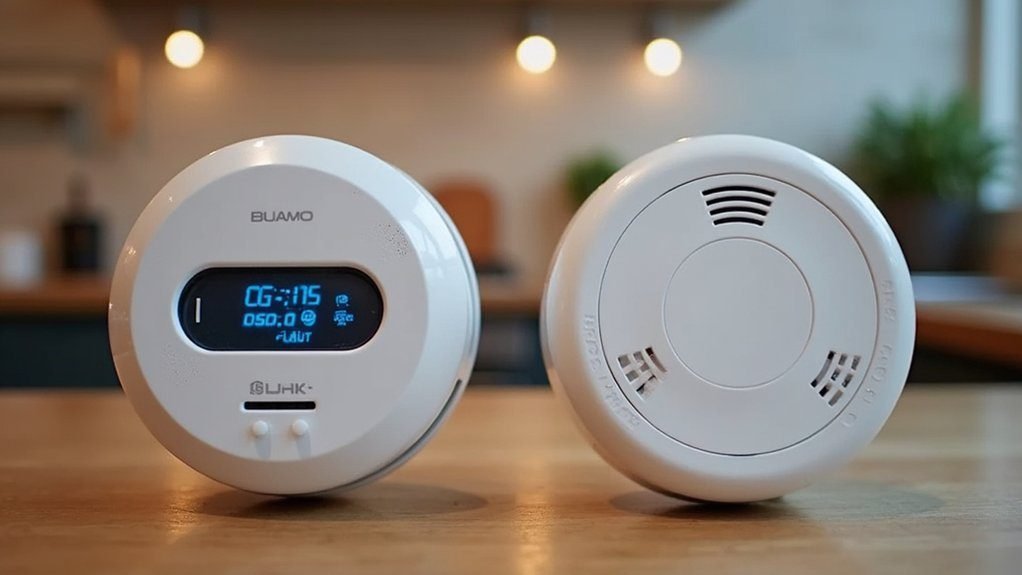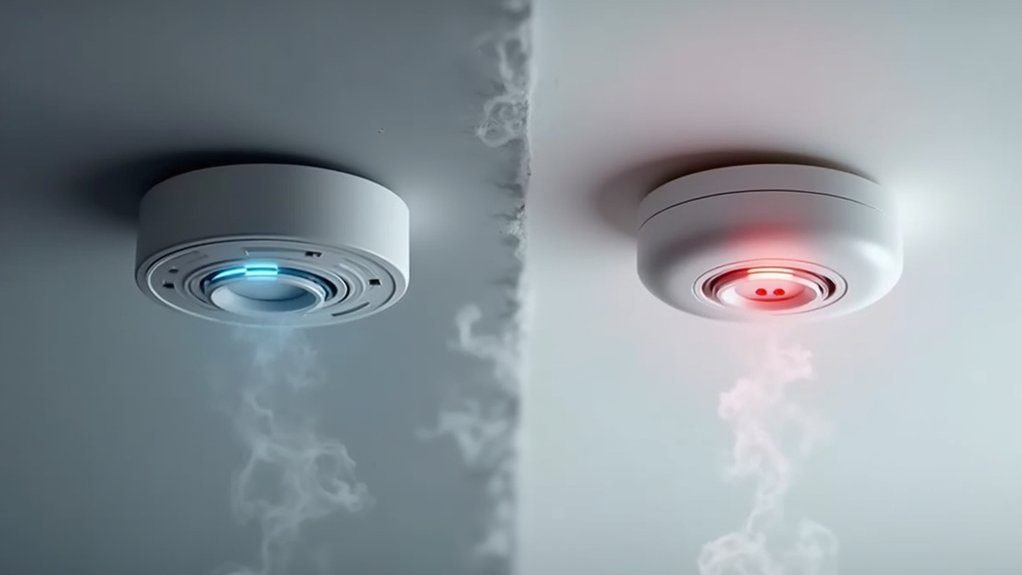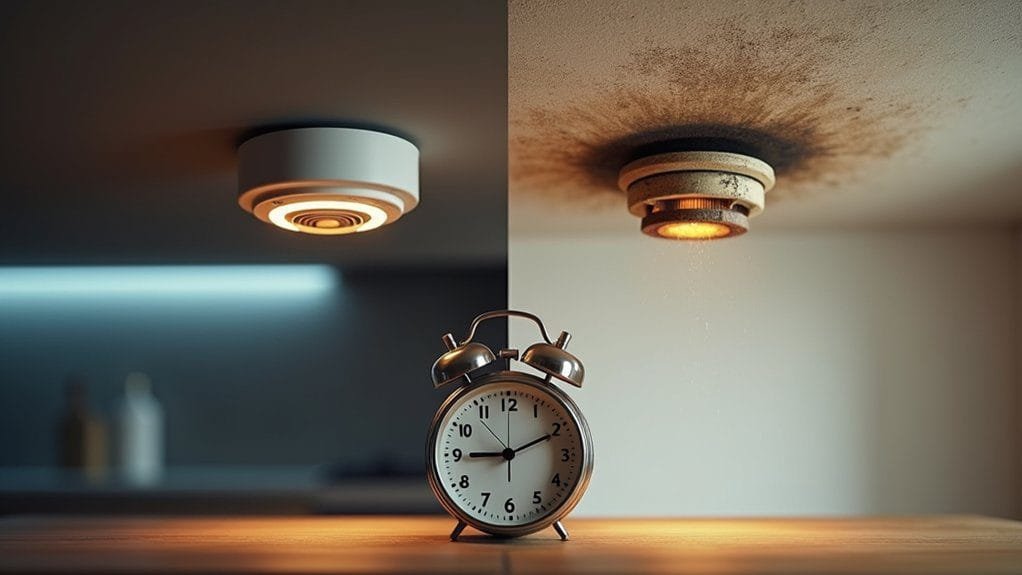When comparing smart and traditional smoke detectors, smart models alert you faster. They send real-time notifications to your smartphone, helping you respond immediately to danger. With advanced technology that reduces false alarms and voice alerts pinpointing the location, you can trust their reliability. Traditional detectors, while effective, mainly rely on loud sirens and require manual upkeep, which can lead to neglect. Want to learn more about the differences and benefits of each type?
Key Takeaways
- Smart smoke detectors send real-time alerts to smartphones, allowing for immediate response, unlike traditional detectors that only emit audible sirens.
- Advanced detection technologies in smart detectors minimize false alarms, ensuring quicker and more reliable alerts during emergencies.
- Smart detectors provide voice alerts with specific location details, enhancing clarity and speed of response compared to traditional models.
- Traditional smoke detectors may take longer to alert occupants, especially if they fail to activate other interconnected alarms.
- Regular self-testing in smart detectors ensures consistent operation and quicker notification of any issues, enhancing overall safety.
Understanding Smart Smoke Detectors


As technology advances, understanding smart smoke detectors becomes increasingly important for enhancing home safety. These devices utilize Wi-Fi or Bluetooth connectivity to send real-time notifications to your smartphone, keeping you informed about potential fire hazards no matter where you are. They come equipped with advanced features like self-testing and voice alerts that specify the danger’s type and location, improving your response time. Many models also integrate carbon monoxide detection, offering dual protection against smoke and toxic gases. With a longer lifespan and less frequent battery replacements—some lasting up to ten years—smart detectors are a practical choice. Additionally, their ability to interconnect with other smart home systems can automate responses, such as turning on lights for emergency responders during a fire.
How Traditional Smoke Detectors Work
While smart smoke detectors are gaining popularity, traditional smoke detectors remain a critical component of fire safety in many homes. These detectors typically utilize either ionization or photoelectric technology. Ionization smoke detectors respond rapidly to fast-flaming fires by ionizing air, where smoke particles disrupt the electric current and trigger the alarm. On the other hand, photoelectric detectors use a light beam that activates the alarm when interrupted by smoke, making them less likely to false alarm from cooking. Most traditional smoke detectors are powered by batteries or are hardwired, requiring regular battery checks. With a lifespan of about 10 years, they guarantee reliability and effective detection, essential for safeguarding your home against fire hazards.
Key Differences in Alert Mechanisms


Understanding the key differences in alert mechanisms between smart and traditional smoke detectors is essential for making informed decisions about home safety. Smart smoke detectors provide real-time alerts directly to your smartphone, enabling immediate awareness during smoke detection. In contrast, traditional smoke detectors emit loud sirens without offering location-specific information.
| Feature | Smart Smoke Detectors | Traditional Smoke Detectors |
|---|---|---|
| Alert Type | Real-time smartphone alerts | Audible sirens |
| Voice Alerts | Yes, with location specifics | No |
| False Alarms | Minimized with photoelectric sensors | More prone to false alarms |
Smart detectors also integrate with smart home devices to enhance emergency response, while traditional detectors may fail without warning.
Advantages of Smart Smoke Detectors
Smart smoke detectors offer several advantages that greatly improve home safety and convenience. Unlike traditional smoke detectors, they provide real-time alerts directly to your smartphone, allowing you to respond immediately, even when you’re away. These devices utilize advanced detection technologies, like Split-Spectrum Sensors, considerably reducing false alarms. Regular self-tests guarantee consistent operation, notifying you of any issues or low battery status. Integration with smart home systems allows for automated actions, such as turning on lights or opening doors for emergency responders, enhancing fire safety. Additionally, many smart smoke detectors include carbon monoxide detection, offering dual protection against fire and toxic gas hazards, making them a smart investment for any home.
Limitations of Traditional Smoke Detectors


Traditional smoke detectors come with several limitations that can compromise safety. Their reliance on basic ionization or photoelectric technology often results in slower response times during certain fire scenarios. Additionally, many of these detectors lack interconnectivity features; if one alarm sounds, others might not activate, delaying critical alerts. While traditional smoke detectors emit loud alarm sounds, they fail to provide specific information about the location or nature of the danger, causing potential confusion in emergencies. With a typical lifespan of around 10 years, they may malfunction if not replaced, increasing the risk of undetected fires. Furthermore, the need for manual maintenance and battery changes can lead to neglect, further compromising their effectiveness.
Real-World Testing and Reliability
While both smart and traditional smoke detectors serve the critical function of alerting you to danger, real-world testing reveals significant differences in their reliability and responsiveness. Smart detectors, like the Google Nest Protect, send alerts to your smartphone within seconds of smoke detection, enhancing your home safety. In contrast, traditional smoke detectors can take longer to alert you, especially in less accessible areas. Smart detectors also perform regular self-tests, ensuring their sensors work correctly and minimizing false alarms. Additionally, their advanced photoelectric sensors identify smoldering fires more quickly. Interconnectivity allows smart detectors to communicate with other alarms throughout your home, ensuring thorough alerts, whereas traditional models may only alert in their immediate vicinity, impacting overall reliability.
Making the Right Choice for Your Home
Choosing the right smoke detector for your home involves weighing the benefits of advanced technology against the simplicity of conventional options. Smart smoke alarms, like Google Nest Protect, offer real-time alerts to your smartphone, ensuring you’re informed even when you’re away. Their advanced detection technologies, such as Split-Spectrum Sensors, reduce false alarms and respond quickly to actual fire threats. In contrast, traditional detectors rely solely on audible alarms and often fail to alert you when you’re not home. Additionally, smart detectors perform self-tests, ensuring they’re operational, while traditional models require manual checks. Integrating smart detectors with home automation systems can facilitate quicker evacuations by activating emergency services and turning on lights during an alarm, enhancing overall fire detection and safety.
Frequently Asked Questions
Which Type of Smoke Detector Works on All Types of Fires and Responds More Quickly to Smoldering Fires Than Ionization Smoke Detection?
Photoelectric sensors excel at fast detection of smoldering fires due to their sensitivity to smoke particles. This detection technology enhances response time, meeting safety standards and improving fire prevention across various fire classifications compared to ionization detectors.
Are Smart Smoke Detectors Worth It?
You might think smart smoke detectors are just expensive gadgets, but their advanced safety features, easy installation, and impressive connectivity options make them worthwhile. User reviews often highlight their reliability, reduced false alarms, and low maintenance needs.
Is Kidde or First Alert Better?
When comparing Kidde and First Alert, consider Kidde’s advantages like affordability and easy installation versus First Alert’s advanced features, user-friendly interfaces, and technology advancements. Customer reviews often highlight safety comparisons, battery life, and warranty options.
What Smoke Detector Do Firemen Recommend?
When it comes to safety, firefighters recommend detectors combining ionization and photoelectric technologies. Consider brands like Kidde or First Alert, focusing on quick response times, maintenance tips, and advanced features for enhanced protection and peace of mind.
Conclusion
In today’s tech-savvy world, choosing between smart and traditional smoke detectors boils down to your needs. Smart detectors offer quicker alerts and added features, while traditional ones stick to the basics. If you want peace of mind, the latest gadgets can notify you from anywhere, like having a personal fire marshal by your side. Ultimately, consider your lifestyle and safety priorities to make the right choice for your home, ensuring you’re always a step ahead of potential dangers.
